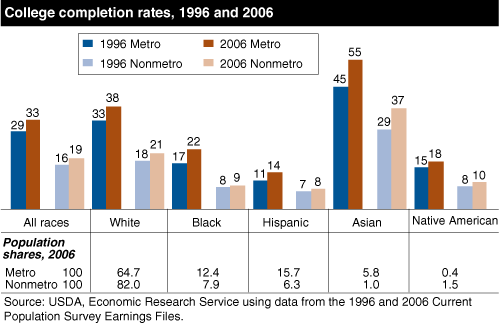College Completion Rates Rise But Nonmetro Areas Continue To Lag
- by Lorin Kusmin
- 4/1/2008
College graduates earn much more than those without a college education, and college graduates are more prevalent in metro than nonmetro areas, which contributes to higher earning levels in metro locales. Recent data from the Current Population Survey show that the metro advantage in college completion rates is growing over time. Between 1996 and 2006, the proportion of prime working-age (25-59) adults who had completed college rose by roughly 14 percent in both metro and nonmetro areas. However, because the college completion rate is higher in metro areas, the absolute size of the metro-nonmetro gap in college completion rates rose over the 10-year period.
College completion rates are higher in metro areas for all major racial and ethnic groups. Differences in college completion rates across racial and ethnic groups are large and persistent, but they do not significantly contribute to widening the metro-nonmetro gap. Metro areas have higher concentrations of Asian Americans, who have the highest college completion rates, and Hispanics, who have the lowest college completion rates.
College completion rates rose across all major racial and ethnic groups in both metro and nonmetro areas between 1996 and 2006. The rates for Whites grew at a similar pace in both metro and nonmetro areas, while the rates for Blacks and Hispanics grew more rapidly in metro areas.
High school completion is also an important factor in determining earnings, and again, metro areas have an advantage, but the difference is much smaller. Between 1996 and 2006, the high school completion rate rose from 84 percent to 87 percent in nonmetro areas, narrowing the gap with metro areas, where the rate increased a single percentage point to 89 percent.
By 2006, high school completion rates for most racial and ethnic groups were 80 percent or more in nonmetro areas and above 86 percent in metro areas. However, high school completion rates for Hispanics remained far lower than for other groups. In 2006, 62 percent of prime-age metro Hispanics and just 60 percent of prime-age nonmetro Hispanics had completed high school, helping explain the lower average incomes received by Hispanics in both metro and nonmetro areas.
This article is drawn from:
- Kusmin, L. (2007). Rural America At A Glance, 2007 Edition. U.S. Department of Agriculture, Economic Research Service. EIB-31.


